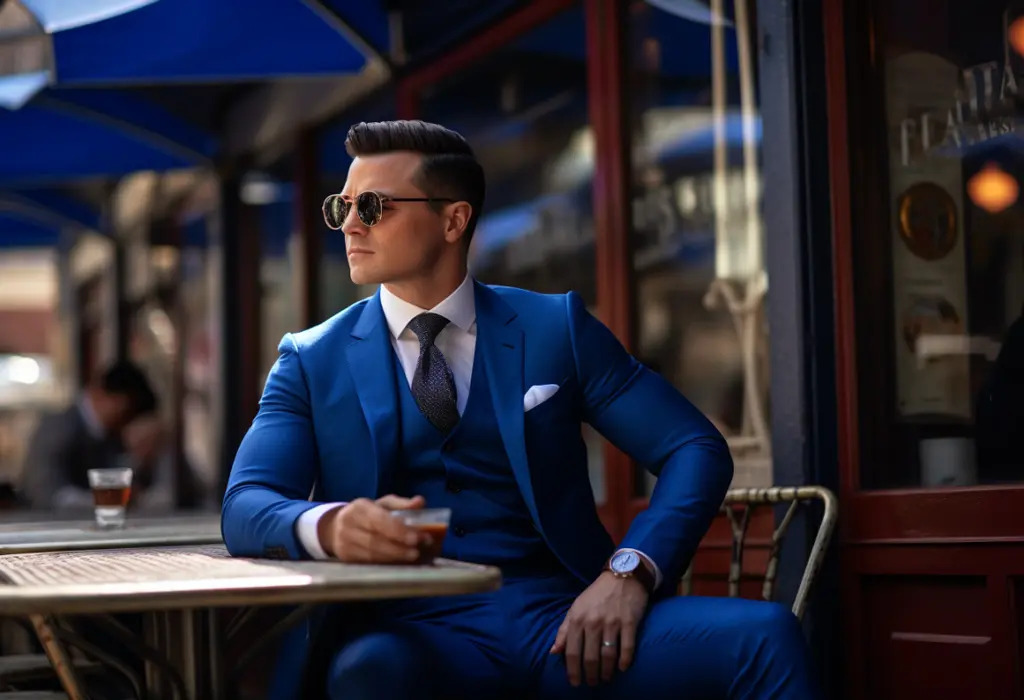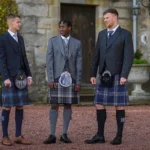
In the rich tapestry of men’s fashion, the suit stands as an enduring icon, transcending time and trends. From its humble origins in 17th-century Europe to the sleek and tailored styles of today, the evolution of the suit reflects not just changes in clothing but shifts in culture, society, and individual expression. This collection of historical facts and numerical trivia delves into the fascinating journey of the suit, exploring key milestones, influential figures, and the intricate details that have shaped this wardrobe essential. Join us on a sartorial journey through time as we unravel the threads of the suit’s history, celebrating its role as a symbol of refinement, versatility, and timeless elegance.
Origin of the Suit:
The modern suit traces its roots back to the 17th century in Europe when men’s fashion underwent a significant transformation. This period marked a departure from elaborate and ornate clothing styles, favoring a more refined and practical approach. The suit emerged as a simplified ensemble, typically consisting of a jacket, waistcoat, and trousers, setting the foundation for the contemporary men’s suit we recognize today.
Birth of the Lounge Suit:
The 19th century witnessed the rise of the lounge suit, a precursor to the modern suit. This evolution in men’s fashion was a response to the changing social landscape and the need for more versatile and comfortable attire. The lounge suit, with its jacket and matching trousers, became a symbol of sophistication and adaptability, transitioning seamlessly from formal to informal occasions.
Introduction of the Tuxedo:
In the late 1800s, the tuxedo emerged as a formal evening alternative, diverging from the conventional tailcoat. Named after Tuxedo Park in New York, where it gained popularity, this stylish ensemble featured a black dinner jacket paired with matching trousers, creating a refined yet less formal option for evening events. The tuxedo became a timeless choice for elegant affairs, solidifying its place in men’s formalwear.
Button Count:
The configuration of buttons on a suit jacket has evolved over the years, with the standard business suit typically boasting two or three buttons. This aspect of design not only serves aesthetic purposes but also influences the formality and silhouette of the garment. The choice between a two-button or three-button jacket often reflects prevailing fashion trends and personal style preferences.
Invention of the Necktie:
The modern necktie has a fascinating evolution, stemming from the cravat and gaining prominence in the 19th century. As a vital accessory to the suit, the necktie’s designs, colors, and knots have become intricate expressions of personal style. Its journey reflects the ever-changing landscape of men’s fashion and the enduring appeal of this small yet impactful detail.
First Men’s Fashion Magazine:
“Gentleman’s Magazine,” established in London in 1731, holds the distinction of being the first publication to delve into men’s fashion. This pioneering magazine played a crucial role in disseminating information about the evolving styles of men’s clothing, including the burgeoning trend of suits. It laid the foundation for the subsequent proliferation of men’s fashion journalism and the cultural significance of tailored attire.
Popularity of Pinstripes:
Pinstripes, a distinctive pattern characterized by narrow lines running parallel to each other, gained popularity in the 1920s. Initially associated with Wall Street businessmen, pinstriped suits became synonymous with professionalism and financial acumen. The pattern’s endurance over the decades attests to its timeless appeal and its ability to seamlessly integrate into both formal and semi-formal settings.
Material Innovation:
In the mid-19th century, a significant shift occurred in the materials used for suits. Wool emerged as a dominant fabric, replacing luxurious materials like silk. This transition was not only driven by practical considerations but also by the desire for a more accessible and versatile garment. The durability, warmth, and adaptability of wool contributed to its establishment as the go-to fabric for suits, shaping the industry’s standards.
Standardization of Sizes:
The early 20th century witnessed a pivotal moment in the history of men’s suits with the standardization of sizes. This development, rooted in the need for mass production and a growing ready-to-wear market, established a system based on chest size and height. The standardized sizing system streamlined the manufacturing process, making stylish and well-fitted suits more widely available to men across various demographics.
Introduction of the Dinner Jacket:
The late 19th century saw the introduction of the dinner jacket, offering a less formal alternative to the traditional tailcoat for evening wear. This stylish jacket, often featuring satin or silk lapels, gained popularity for its versatility and comfort. The dinner jacket became a staple in men’s formal attire, especially for events where a full evening gown was not required, contributing to the evolution of men’s fashion during this era.
First Men’s Department Store:
Brooks Brothers, established in 1818 in New York, holds the distinction of being the first men’s department store. Founded by Henry Sands Brooks, the store quickly became a hallmark of quality and innovation in men’s fashion. Brooks Brothers played a pivotal role in popularizing the suit, introducing ready-to-wear clothing and implementing standardized sizing, contributing significantly to the evolution of men’s retail and fashion.
Influence of Beau Brummell:
George Bryan “Beau” Brummell, a Regency dandy in the early 19th century, left an indelible mark on men’s fashion. Known for his impeccable taste and grooming, Brummell popularized the modern suit and established sartorial norms that emphasized simplicity, cleanliness, and a tailored fit. His influence extended beyond clothing, shaping the concept of the well-dressed gentleman and setting standards that endure to this day.
Rise of Italian Style:
The mid-20th century witnessed the ascent of Italian tailoring as a global fashion force. Italian designers, such as Giorgio Armani and Brioni, redefined men’s fashion with a focus on craftsmanship, quality fabrics, and a distinctive sense of style. This shift marked a departure from the traditional British and American styles, and the Italian influence continues to resonate in modern menswear.
Introduction of Zippers:
In the 1930s, a significant innovation transformed the closure of men’s trousers—the introduction of zippers. This replaced the traditional button-fly design, offering convenience and a sleeker appearance. Zippers became a standard feature in men’s pants, reflecting a broader trend toward modernization in fashion during the early to mid-20th century.
Evolution of Lapels:
The width of suit lapels has undergone various transformations over the years, with broader lapels gaining popularity in the 1970s. This era embraced bold fashion choices, and wider lapels became a symbol of style and confidence. The evolution of lapel widths serves as a visual timeline, reflecting the prevailing tastes and trends of each fashion epoch.
Advent of Ready-to-Wear Suits:
The early 20th century witnessed a paradigm shift with the advent of ready-to-wear suits. This departure from traditional bespoke tailoring made fashionable clothing accessible to a broader audience. Ready-to-wear suits, produced in standard sizes and readily available in stores, democratized fashion, allowing men from various walks of life to embrace stylish and well-fitted attire.
First Fashion Show:
The Plaza Hotel in New York set the stage for a historic event in 1943—the first men’s fashion show. This groundbreaking showcase marked a departure from traditional presentations, bringing together designers, models, and industry professionals to exhibit the latest trends in men’s fashion. The event laid the groundwork for the modern fashion show and its role in shaping industry trends.
Role of Savile Row:
Savile Row, located in London’s Mayfair district, has been synonymous with bespoke tailoring since the late 18th century. Renowned for its craftsmanship and attention to detail, Savile Row tailors have catered to discerning clients, including royalty and celebrities. The street’s legacy continues to influence global menswear, representing the epitome of traditional British tailoring.
Introduction of the Trench Coat:
The trench coat, initially developed for military use during World War I, became an iconic outerwear piece often worn over suits. Designed for officers in the trenches, its features, including a belted waist and storm flaps, contributed to its functionality and timeless style. The trench coat’s crossover into civilian fashion solidified its status as a classic and versatile wardrobe staple.
Notable Suit-Wearing Icon:
James Bond, the fictional British spy created by Ian Fleming, emerged as a symbol of sophistication and style. Since the character’s introduction in the 1950s, James Bond has been impeccably dressed in tailored suits crafted by renowned designers. This iconic representation significantly influenced men’s fashion, showcasing the enduring allure of a well-fitted suit in both cinematic and real-world contexts.
Slim-Fit Trend:
The mid-2000s witnessed a resurgence of interest in slim-fit suits, marking a departure from the looser cuts of the previous decades. This trend emphasized a more tailored and form-fitting silhouette, reflecting a shift toward modernity and a renewed focus on youthful, stylish aesthetics. The slim-fit trend has since become a staple in men’s fashion, offering a contemporary take on classic suiting.
High-End Suit Records:
The pinnacle of luxury in menswear is epitomized by Stuart Hughes’ creation of the world’s most expensive suit, valued at a staggering $3.2 million. This bespoke suit is adorned with diamonds and gold, showcasing the fusion of high-end craftsmanship and opulence. While this extravagant creation remains an outlier, it symbolizes the limitless possibilities within the realm of luxury menswear.
Introduction of Synthetic Fabrics:
In the mid-20th century, a notable shift occurred with the introduction of synthetic fabrics like polyester in suit construction. These materials offered affordability, durability, and resistance to wrinkles, catering to a broader market. The adoption of synthetic fabrics contributed to the democratization of men’s fashion, making suits more accessible and easier to maintain for a diverse range of consumers.
Average Number of Suits Owned:
Surveys indicate that the average American man owns approximately three suits. This statistic reflects a practical approach to wardrobe management, with individuals typically owning suits for different occasions, such as work, formal events, and social gatherings. The figure underscores the enduring relevance of the suit as a versatile and essential component of a well-rounded wardrobe.
Influence of Fashion Designers:
Fashion designers have played a pivotal role in shaping men’s fashion, with notable figures like Giorgio Armani, Ralph Lauren, and Yves Saint Laurent leaving an indelible mark. Armani revolutionized menswear with his relaxed and elegant designs, while Ralph Lauren epitomized American style with his preppy and classic aesthetics. Yves Saint Laurent’s innovations challenged traditional gender norms, contributing to a more diverse and expressive landscape in menswear. The influence of these designers extends beyond clothing, shaping cultural perceptions of masculinity and individual expression through fashion.









